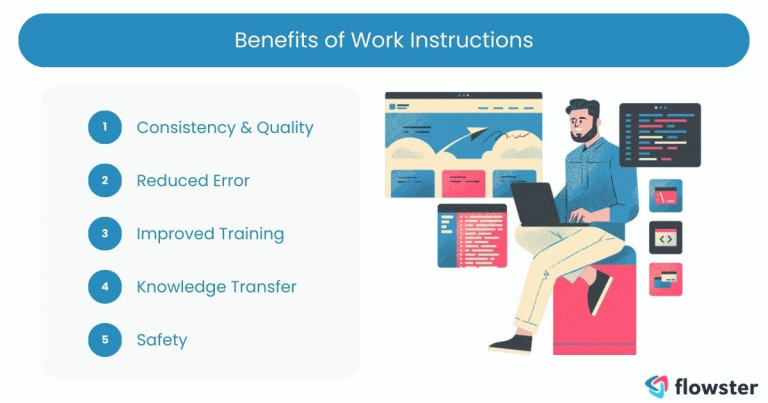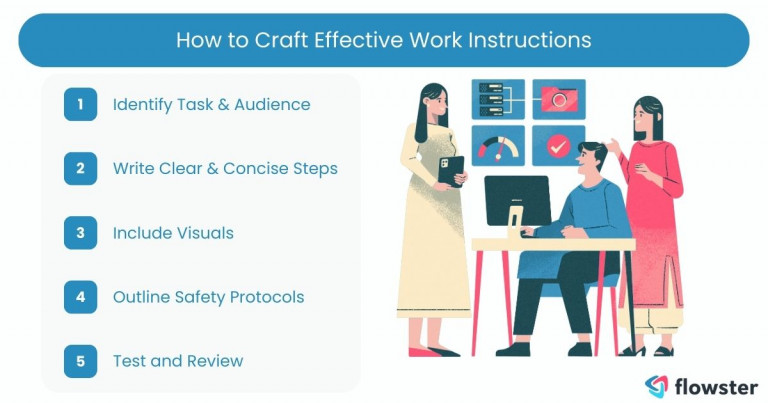Have you ever spent hours wrestling with flat-pack furniture, deciphering cryptic diagrams, and wishing for a single, clear instruction sheet? We’ve all been there. In the workplace, the frustration of unclear instructions can be even more costly, leading to wasted time, errors, and inconsistencies. This is where work instructions come in, acting as the missing puzzle piece for a smooth and efficient workflow.
Work instructions are detailed guides that provide employees with a step-by-step roadmap for completing specific tasks. They ensure everyone is on the same page, promoting consistency in quality and minimizing the risk of mistakes. From manufacturing assembly lines to customer service procedures, clear work instructions are essential tools for businesses of all sizes.
Article Outline
What are Work Instructions and Why They Matter?
Let’s ditch the frustration of guesswork! Work instructions are detailed guides that meticulously outline the steps involved in completing a specific task. Imagine them as a recipe for success, ensuring everyone on your team follows the same approach and achieves consistent, high-quality results.
But the benefits of work instructions extend far beyond simply getting things done right. Here’s how clear and concise work instructions can empower your business:
- Consistency & Quality: By providing a standardized approach, work instructions ensure tasks are completed uniformly across the board. This reduces variability and helps maintain consistent quality in your products or services.
- Reduced Errors: Clear instructions leave no room for misinterpretation. This minimizes errors and the need for rework, saving valuable time and resources.
- Improved Training: Work instructions act as a valuable training tool for new hires. They provide a clear roadmap for learning job duties and can significantly accelerate the onboarding process.
- Knowledge Transfer: Work instructions capture and document best practices, ensuring valuable knowledge isn’t lost with employee turnover. This facilitates knowledge transfer within teams and across departments.
- Safety: For tasks that involve potential hazards, work instructions can outline specific safety procedures. This helps create a safer work environment and minimizes the risk of accidents.
With so much to offer, it’s clear that work instructions are a powerful tool for any business. In the next section, we’ll explore some real-world examples of how work instructions are used in various industries.

Examples of Common Work Instructions
Work instructions are a versatile tool applicable across various industries. Let’s take a look at some everyday examples of how businesses leverage work instructions.
- Manufacturing: On a bustling assembly line, clear work instructions ensure each worker performs their tasks efficiently and consistently. These instructions might detail specific procedures for assembling a product or operating complex machinery.
- Customer Service: Have you ever received exceptional service from a customer support representative who seemed to effortlessly resolve your issue? Chances are, they were following well-defined work instructions. These instructions outline standard processes for handling inquiries, complaints, and returns, ensuring a smooth and consistent customer experience.
- Administration: From processing expense reports to entering data or troubleshooting IT glitches, administrative tasks often require specific steps. Work instructions can provide clear guidelines for these tasks, boosting accuracy and efficiency
- Retail: Ensuring a seamless shopping experience for customers relies on well-trained staff. Work instructions can guide cashiers on proper checkout procedures or outline product stocking guidelines for a visually appealing and organized store layout.
- Remote Work: The rise of remote work has introduced new challenges in maintaining clear communication and project management. Work instructions can establish expectations for communication tools, deadlines, and project deliverables, fostering a collaborative and productive remote work environment.
As you can see, work instructions are valuable tools that can be adapted to fit the needs of any organization. In the next section, we’ll delve into the key steps for crafting effective work instructions that empower your team for success.

Crafting Effective Work Instructions: A Step-by-Step Guide
So, you’re convinced of the power of work instructions, but where do you begin? Here’s a step-by-step guide to crafting effective work instructions that will empower your team:
Step 1: Identify the Task and Audience:
The first step is to clearly define the specific task your work instructions will address. Who will be using these instructions? Are they seasoned professionals or new hires? Tailoring the language and level of detail to your audience ensures the instructions are clear and understandable.
Step 2: Develop Clear and Concise Steps:
Break down the task into a logical sequence of steps. Use simple, easy-to-understand language and avoid technical jargon. Numbering each step makes it easy for users to follow the process.
Step 3: Include Visual Aids:
A picture is worth a thousand words! Supplement your written instructions with visuals like pictures, diagrams, or even screenshots. This can be particularly helpful for complex tasks or those involving specific equipment.
Step 4: Consider Safety Precautions:
For tasks that involve potential hazards, identify these risks and outline clear safety protocols within your work instructions. This helps promote a safe work environment and minimize accidents.
Step 5: Review and Test:
Before finalizing your work instructions, get feedback from colleagues familiar with the task. Ask them to review the instructions for clarity, accuracy, and ease of understanding. This testing phase allows you to refine your instructions and ensure they are truly effective.
By following these steps, you can create clear, concise, and informative work instructions that empower your team and optimize your workflow.

The Power of Clear Work Instructions: Streamlining Your Workflow
In today’s fast-paced business environment, clear and concise work instructions are no longer a luxury; they’re a necessity. As we’ve seen, well-crafted work instructions offer a multitude of benefits, including promoting consistency, minimizing errors, streamlining training, and fostering a safer work environment.
By equipping your team with clear work instructions, you empower them to perform their tasks efficiently and confidently. This translates to increased productivity, improved quality, and a more positive work experience for everyone.
Ready to unlock the power of work instructions for your business? Start by identifying key tasks that could benefit from clear guidelines. Then, follow the step-by-step guide outlined above to craft effective work instructions tailored to your specific needs.
Bonus Tip: Consider utilizing software solutions designed for creating and managing work instructions. These tools can streamline the process, facilitate collaboration, and ensure your work instructions are readily accessible to your team.
Investing in clear work instructions is an investment in the success of your business. So, take the first step today and watch your workflow flourish!
Simplify Work Instruction Creation
Software like Flowster offers pre-built templates to jumpstart your work instructions. Need a hand? Their “Done-for-You” service creates custom instructions tailored to your business.




